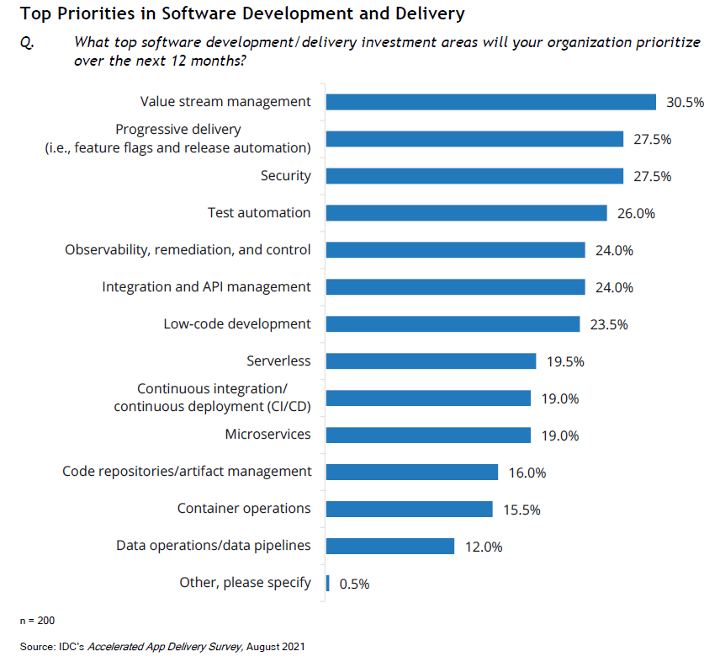Fueling Synergy Across the Enterprise: IDC's View on Converged Testing Automation

With growing demand to achieve digital transformation initiatives, many organizations have implemented robotic process automation (RPA) and application testing to maximize their business outcomes. According to IDC’s “PaasView and the Developer 2021” survey results, software developers listed lack of automation as the biggest obstacle to achieving optimal productivity (IDC #US47836121, June 2021). The onset of the pandemic in 2020 has also prompted many organizations to prioritize the role of automation in the digitalization of work. So how exactly do RPA and application testing influence each other and work together? And what kind of impact can they have on business optimization?
In this post, we’ll explore key takeaways from the recent IDC white paper, sponsored by UiPath, Leveraging RPA and Software Quality Automation to Help Enable Application and Business Optimization. First, we’ll look at some of the software development trends that shape the RPA and testing landscapes. Then, we’ll dive into RPA and automated testing in more detail.
Key software development trends across organizations
Due to business needs and strategies ever evolving, software development priorities continue to change year after year. Featured in the white paper, IDC's Accelerated App Delivery Survey (IDC #47924622, January 2022) revealed the following information from organizations:
Time constraint pressures when developing software grew immensely—91% of organizations released software features with a lead time (the amount of time from when someone asks for a feature to when it's delivered) of a month or less in 2021, a substantial increase of 26% compared to just a year prior.
Almost half of organizations reported that they have “industrialized and integrated software capabilities with some business alignment,” demonstrating that process changes must occur with support from technologies to fully align with business strategies.
72.5% of organizations have increased their “adoption of advanced testing and software development strategies,” including using technologies such as artificial intelligence (AI) and automated testing rather than manual testing.
Many organizations reported software delivery management, processes, security, and automated testing as their top priorities for software development over the next year.

Around 40% of organizations in 2021 described themselves as being in a “reinvention” phase due to digital disruption from the pandemic and its aftermath (as compared with 17% in 2020’s PaaSView and the Developer survey), prompting the opportunity to leverage RPA to automate tasks. At the same time, “staying the course” declined from 29% in 2020 to 15% in 2021.
Based on these trends, RPA and testing play a significant role in enabling organizations to effectively meet timelines and thoroughly uphold business strategies.
How RPA benefits software testing
RPA can provide several benefits to organizations, including:
Improving efficiency of business processes
Reducing time spent on manual tasks
Increasing team productivity
By leveraging RPA with testing, teams can automate tedious manual testing activities. For example, they can streamline processes for creating test data, reporting on delivery statuses, and developing test plans.
Synergy between testing and RPA
When considering the relationship between testing and RPA, IDC noted that “applying design thinking and leveraging RPA and automation also has the potential to make testing accessible—to humanize testing approaches and engage business subject matter experts as well as citizen developers to contextualize quality.”
By using automated testing, software testers can test at a greater scale in a more efficient way. For example, they can use RPA to combine reports for failed test cases that need support or to generate test data. There are also opportunities for testers to use testing and RPA to automate across both traditional applications as well as legacy software.
Furthermore, testing and RPA are both particularly needed when looking at assets required for application user interfaces (UIs). Using testing and RPA together, teams can lower the costs of maintaining systems and deliver results more quickly.
Opportunities to improve RPA through testing
According to IDC, automated testing can help address RPA challenges, including its complexity, brittleness, and governance and documentation requirements. Given its extensive history, the testing industry provides experience and context that RPA can leverage. For example, testing provides a foundation for creating organized libraries to achieve maintenance and efficiency. Testing can also support the creation of a more structured framework in enhancing the quality of RPA. Additionally, testing allows for users to test not only the automations, but also the applications that the automations enable.
Optimizing your business through both RPA and testing
By leveraging both RPA and testing together, organizations can enhance their testing quality. They can also improve the effectiveness of RPA by reusing automations to build a more efficient and durable environment. Through this, companies are equipped to achieve their automation, business strategy, digital transformation, and innovation goals. And what helps organizations transform their business in these ways?
With the UiPath Test Suite product portfolio, users can engage in both RPA testing and software application testing with production-grade, low-code automation. Test Suite enables teams to build automations more quickly, test almost any kind of technology, and fix issues to keep businesses running smoothly. According to the most recent IDC MarketScape: Worldwide Cloud Testing 2022 Vendor Assessment – Empowering Business Velocity (doc #US47097221, March 2022), one reference used both RPA and UiPath Test Suite and saved time equating to $2.5 million in savings for the company, demonstrating the potential to transform quality assurance from a cost center to a value contributor. Another customer used UiPath Test Suite to improve their release velocity (how quickly new software updates are released) from every eight months to monthly.
Discover how you might be able to achieve similar amazing results by signing up for a free trial of UiPath.
This post was co-authored by Sophie Gustafson, Product Marketing Content Strategist at UiPath.

Research Director, Agile ALM, Quality & Portfolio Strategies, IDC
Get articles from automation experts in your inbox
SubscribeGet articles from automation experts in your inbox
Sign up today and we'll email you the newest articles every week.
Thank you for subscribing!
Thank you for subscribing! Each week, we'll send the best automation blog posts straight to your inbox.



